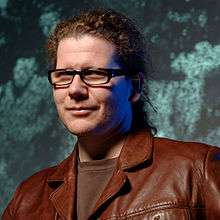Charles Sandison
| Charles Sandison | |
|---|---|
 | |
| Born |
24 April 1969 Haltwhistle, Northumberland, England |
| Nationality | British |
| Education | Glasgow School of Art, Glasgow |
| Known for | Media art, Computer art |
| Notable work |
Living Rooms (2001) The River (2010) |
| Awards | Ars Fennica Prize (2010) |
Charles Sandison (born 24 April 1969) is an English born Scottish visual artist who lives and works in Tampere, Finland.
Biography
Sandison was born in Haltwhistle, Northumberland and grew up in Wick, Caithness. Sandison was always interested in computing; at the age of 12, he taught himself to code on his computer. He went on to study art (at the Glasgow School of Art) from 1987–1993 and briefly taught there after graduating. In 1995 Sandison moved to Finland and now resides permanently in Tampere.
During the early 1990s Sandison exhibited alongside Young British Artists in such shows as; Wonderful Life, Lisson Gallery, London (1993) and Institute of Cultural Anxiety: Works from the Collection Institute of Contemporary Arts, London (1994). During a 5-year hiatus in which Sandison moved away from the United Kingdom and occupied the position of Head of Fine Art at Tampere School of Art and Media. He came to wider recognition in 2001 after exhibiting in the Venice Biennale. In 2004 Sandison became a visiting professor at Le Fresnoy, Lille. In 2010 Sandison was awarded the Ars Fennica prize by President of Finland Tarja Halonen.[1]
Artwork

Much of Sandison's work involves computer generated video projections that create immersive data installations, placing the viewer at the centre of a changing universe of words, signs, and characters. Sandison's art works to incorporate the viewer into the piece, so that the computer and human mind can work together. Sandison draws inspiration from nature and his surroundings, and attempts to capture elements of human life and the current world that we live in. He stated in a private interview, "I don't try to make a copy or representation of something and I don't make objects. I try to create something that has its own life. I guess I am the Dr. Frankenstein of the art world." (Student Interview, 2015) The importance of location in his work has led to projections in the Paris Catacombs, and the Forum Romano.
"Sandison has made his breakthrough by showing large works on major international stages. In formal terms his works are a digital surface, watchable, suitably simple, minimalist in their repetition, but also spectacular and, at the same time, beautiful."[2]
"Mr. Sandison's works are not compelling in traditional visual ways, but they are philosophically intriguing. You can imagine some more highly evolved version of what he does as a primary art form in some sci-fi world of the future."[3]
Awards
(2010) Ars Fennica Prize[4]
External links
- Official site
- Works in the Finnish National Gallery
- Baronian-Francey: Charles Sandison
- Yvon Lambert: Charles Sandison
- Ars Fennica Prize 2010: Charles Sandison
- Sandison's work The River (2010) on Google Art Project
Notes
- ↑ Artist wins Finland's answer to Turner Prize, BBC News, December 11th, 2010.
- ↑ Catalogue text, Perttu Rastas, Singapore Biennale 2011. ISBN 978-981-08-8050-7.
- ↑ Hello World, Art In Review, New York Times, Johnson, Ken. July 15th, 2005
- ↑ 'Ars Fennica Prize website'. Retrieved 12 April 2011.
